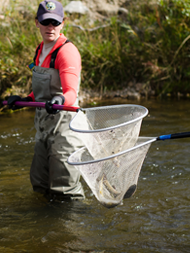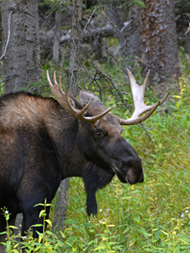North American Model of Wildlife Conservation (NAMWC)
Page Content

Learn About our Guiding Principles and Influencing Factors
Overview
The North American Model of Wildlife Conservation is the cornerstone of modern wildlife conservation across the U.S. This revolutionary model was formed around the turn of the 1900's when sportspeople realized that market hunting was taking an undeniable and potentially irreversible effect of North America's wildlife. Looking toward the future these visionaries determined that to ensure the health and longevity of all wildlife, a structured system needed to be created.
A major concept that came from this new management model was a funding concept that makes all of our conservation efforts possible today. This model is still the most successful wildlife management model in the world.
In short, the revenue generated from hunting and fishing activities constitutes about
70 percent of our wildlife management funds. For almost two centuries, this model has been a large part of the reason why Colorado’s wildlife is so healthy and abundant.
What is Conservation?
Conservation is the wise use of a resource. For natural resource and wildlife management, this means the planned and regulated use of our resources to prevent exploitation, destruction or extinction.
What is the North American Model of Wildlife Conservation?
The model is governed by two basic ideals and seven conservation principles. In its most basic form, the model rests on the guidelines that:
Fish and wildlife are for the non-commercial use of citizens.
They should be managed in such a way that sustains their populations forever.
The “Seven Sisters” guidelines allow for slightly deeper exploration into these conservation principles.
Wildlife in the Public Trust
The public trust doctrine means that wildlife belongs to everyone. Natural resources and wildlife on public lands are managed by government agencies to ensure that current and future generations always have wildlife and wild places to enjoy.
Elimination of Markets for Game
Commercial hunting and the sale of wildlife are prohibited to ensure the sustainability of wildlife populations.
Allocation of Wildlife by Law
Wildlife is allocated to the public by law, as opposed to by market principles, land ownership, or other status. Hunting and fishing laws are created through the public process, meaning everyone has the opportunity and responsibility to develop systems of wildlife conservation and use. Democratic processes and public input in lawmaking help ensure that access is equitable.
Wildlife can be killed only for a legitimate purpose
The killing of game must be done only for food, fur, self-defense, and the protection of property (including livestock). Laws restrict against the casual killing of wildlife merely for antlers, horns or feathers.
Wildlife is an international resource
Wildlife and fish migrate freely across boundaries between states, provinces and countries. Many positive agreements and cooperative efforts have been established among the U.S., Canada, Mexico, and other nations for conserving wildlife.
Science is the basis for wildlife protection
The North American Model recognizes science as a basis for informed management and decision-making processes. Research and tracking help us to best conserve our resources.
Democracy of Hunting
By law, every citizen of good standing has the opportunity to hunt and fish in the United States and Canada.

Who Is Involved?
The NAMWC is implemented throughout the United States. In Colorado, the model has helped species like
lynx,
moose,
black-footed ferrets, elk, and
turkeys among many others. The millions of dollars generated by hunters and anglers - through license sales as well as excise taxes on equipment and firearms - are the reason this model works.
Why is the North American Model of Wildlife Conservation Important?
Although the
State Wildlife Grant program is an immense help in providing reliable funds for conservation efforts, revenues from hunters and anglers make up the bulk of conservation funding. These principles allow for the sustainable use of our wildlife resources by setting basic guidelines. Through scientific reasoning and democratic processes, we can all protect Colorado’s wildlife.

